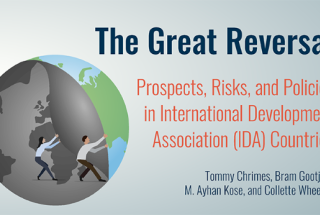World Bank: The Great Reversal: Prospects, Risks, and Policies in IDA Countries

‘The Great Reversal: Prospects, Risks, and Policies in IDA Countries’ was just released by Prospects Group, World Bank. Prospects Group is led by CAMA Research Associate, M. Ayhan Kose (Deputy Chief Economist and Director).
Buffeted by an unprecedented series of shocks, the global economy has shown extraordinary resilience so far. That’s the good news—or so it might seem. What is going largely unnoticed, however, is the plight of the 75 poorest and most vulnerable economies—the ones eligible for grants and low-interest loans from the World Bank’s International Development Association (IDA). A new study is just released by World Bank, “The Great Reversal: Prospects, Risks, and Policies in IDA Countries,” to shed light on the challenges they face. These countries had made notable progress against some important development objectives over the first two decades of this century. However, on the eve of the COVID-19 pandemic, significant development gaps persisted, income convergence with advanced economies was slowing, and some vulnerabilities were rising. We take stock of developments since the pandemic and report three major findings.
Reversal in development: The shock of the pandemic and subsequent overlapping crises has exacerbated the challenges facing these economies and led to a reversal in development: over 2020-24, per capita incomes in half of IDA countries—the largest share since the start of this century—are set to grow more slowly than those of wealthy economies. One out of three IDA countries is poorer than it was on the eve of the pandemic. Poverty remains stubbornly high, hunger has surged, and, amid fiscal constraints and rising investment needs, the development outlook could take an even bleaker turn—especially if weak growth prospects persist.
High potential: IDA countries have high economic potential that can be unlocked. History offers many examples of IDA countries that overcame multifaceted development challenges. Large economies such as China, India, and Korea successfully graduated from IDA and are now important engines of the global economy. Many current IDA countries possess abundant natural resources, including substantial reserves of minerals critical to the global energy transition. Many also have the potential to reap large demographic dividends, with working-age populations expected to surge over the next half-century. These resource and demographic endowments carry well-documented risks, and leveraging their potential is not a straightforward task. Nevertheless, if well-managed, they represent major opportunities.
Need for ambitious policies and significant global support: Capitalizing on the benefits of their advantages and boosting investment to meet their needs will require them to undertake comprehensive policy measures to bolster fiscal and monetary frameworks, enhance human capital development, and improve the quality of institutions. In many IDA countries, fostering stability will be an important contributing factor too. These policies should be complemented with significant and consistent international financial support as well as strong cooperation on global policy issues. This is essential for giving IDA economies the best chance of a brighter future—and in turn, progress in IDA countries is imperative if the world is to have a reasonable chance of securing long-term peace and prosperity.
Source
World Bank: The Great Reversal: Prospects, Risks, and Policies in IDA Countries
Updated: 27 July 2024/Responsible Officer: Crawford Engagement/Page Contact: CAMA admin










